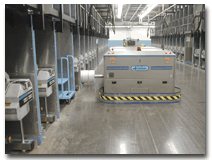Burlington Industries Inc., Greensboro, N.C., reported a net loss for the second quarter of its
fiscal year, primarily due to costs associated with the previously announced reorganization of the
companys apparel products segment. The net loss for the quarter was $47.9 million, or $0.86 per
diluted share, compared with net income of $24.6 million, or $0.40 per diluted share for the second
quarter of the 1998 fiscal year. This loss includes $49 million after tax, or $0.88 per share for
the restructuring and run-out expenses, and reduced earnings from a joint venture due to its
restructuring.Net sales for the second quarter of fiscal 1999 were $403.9 million, compared with
$518 million for the second quarter of 1998.For the first six months of fiscal 1999, there was a
net loss of $39.9 million, or $0.70 per diluted share, compared with net income of $37.8 million of
$0.62 per diluted share for the first six months of fiscal 1998. Net sales for the first six months
of fiscal 1999 were $811.1 million, compared with $999.7 million for the first six months of fiscal
1998.Burlington also announced that its board of directors authorized $10 million for the
repurchase of shares of Burlington Industries common stock. The repurchase is expected to reduce
shares outstanding by approximately two percent.Clariant International Ltd., Switzerland, reported
improved earnings for 1998 both in absolute figures and as a margin despite a fall in divisional
sales to CHF 9,341 million.The six divisions generated operating income of CHF 1,174 million, up 4
percent from the 1997 figure of CHF 1,128 million. In terms of divisional operating margins, this
equates to an increase from 11.4 percent to 12.6 percent of sales. EBIT after deduction of
corporate costs and the write-off of goodwill came to CHF 1,057 million, equivalent to a 7-percent
increase.Net income soared up 23 percent from CHF 422 million to CHF 519 million, corresponding to
earnings per share of CHF 36.25 (up 25 percent from the previous year).CromptonandKnowles Corp.,
Stamford, Conn., reported that first quarter diluted earnings per share before special items
increased 12 percent to $0.47 ($32.4 million) from $0.42 ($31.8 million) in last years first
quarter.Special items included an after-tax gain of $0.39 per diluted share ($26.8 million)
relating to the sale of the specialty ingredients business in 1999 and an extraordinary loss on
early extinguishment of debt of $0.03 per diluted share ($2 million) in 1998.Net earnings per
diluted share in the first quarter of 1999 more than doubled to $0.86 ($59.2 million) from $0.39
per share ($30 million) in the first quarter of 1998.Earnings per share benefitted by the companys
stock buy-back program as weighted average shares outstanding decreased to $69.2 million diluted
from $76.4 million diluted in the first quarter of 1998.Dan River Inc., Danville, Va., reported
results for the first quarter ended April 3, 1999.Net sales were $169.5 million, up $48.6 million
from $120.9 million for the first quarter of 1998. For the current quarter, the company reported
net income of $1.6 million or $0.07 per basic share. This compares to net earnings of $5.4 million
or $0.29 per basic share for the first quarter of 1998.Sales of Home Fashions products for the
first quarter of 1999 were $117.4 million, up $47.8 million from the first quarter of 1998.The
company also reported that sales of Apparel Fabrics were $40.2 million, down $11.1 million from the
1998 first quarter. Sales of Engineered Products were $11.9 million.The Dixie Group Inc.,
Chattanooga, Tenn., reported net income for the first quarter ended March 27, 1999, of $2.6
million, or $0.22 per share on a diluted basis. This is an increase of 15 percent compared with
income from continuous operations of $2.2 million, or $0.19 per share in the first quarter of
1998.Sales for the quarter were $141.2 million, up 19 percent versus $118.6 million in 1998.The
Lectra Systs Group, Paris, announced it shows a strong growth in profits for the first quarter of
1999. At constant currencies and consolidation scope, compared with 1998, revenues are up by 8
percent and income from operations is up by Euro 2.5 million (FFr 16 million).Cash provided by
operating activities before change in working capital has increased by 168 percent to Euro 4.4
million (FFr 29 million).The decrease in the free cash flow produced during the first quarter comes
principally from the temporary increase of the need for working capital, and from the
implementation of the companys investment plan allocated to its development.Pillowtex Corp.,
Dallas, announced that net earnings for its quarter ended April 3, 1999 were $5.3 million or $0.31
per diluted share, as compared to $5.6 million or $0.33 per diluted share, for the corresponding
period of 1998.The company reported that net sales for the first quarter increased to $368.5
million from $366.3 million in the same quarter of 1998.Gross profit achieved for the first quarter
of 1999 was $56.2 million, or 15.3 percent of net sales, as compared to $61.5 million, or 16.8
percent of net sales for the same period in 1998.Selling, general and administrative expenses for
the first quarter of 1999 were $28.1 million, a decrease from $33.7 million for the same period of
1998, reflecting the continued success of the companys reduction plans implemented in connection
with the Fieldcrest Cannon acquisition.Russell Corp., Alexander City, Ala., reported results for
the first quarter of 1999 ended April 4, 1999.Sales were $233.177 million, down 9 percent from the
previous years $256.229 million. The company recorded a loss of $14.351 million, or $0.41 per
share. The results include an after-tax charge of $17.94 million, or $0.51 per share related to
certain non-recurring expenses and severance and the write down and sale of assets in the quarter
included as part of a multi-year strategic plan that was announced in July 1998.Excluding
non-recurring expenses and charges associated with the strategic plan, net income for the current
quarter was $3.589 million versus $1.849 million reported last year and earnings were $0.10 versus
$0.05 per share, for basic and diluted, over the same period in 1998.Thomaston Mills Inc.,
Thomaston, Ga., reported results for the first quarter ended April 3, 1999.Sales for the quarter
were $60,740,000 compared to $68,710,000 the year before. Most of the sales decline resulting from
the sale of the Rattlers Division and reduced sales yarn volume.Wellman Inc., Shrewsberry, N.J.,
reported net earnings before an accounting change of $.8 million, or $0.06 per share, for the
quarter ended March 31, 1999.Net earnings were reduced by the cumulative effect of an accounting
change, required under the AICPAs SOP No. 98-5 and related to start-up expenses.The company
reported net earnings, excluding unusual items, of $0.05 per share and $0.41 per share in the
fourth and first quarters of 1998, respectively.Net earnings for the first quarter of 1999 were
stable compared to the fourth quarter of 1998, excluding unusual items. Higher profits in the
Recycled Products Group (RPG) offset lower profitability in the Fibers and Packaging Products
Groups, resulting from lower polyester fiber and PET resins selling prices. RPG profits increased
mainly because of lower recycled raw material costs in the fibers business and improvements in
other divisions.X-Rite Inc., Grandville, Mich., announced its financial results for the first
quarter ended April 3, 1999.Net sales of $23.7 million and net income of $3 million, or $0.14 per
share compared with net sales of $23.6 million and net income of $3.1 million, or $0.15 per share
for the same period in 1998.The Zellweger Luwa Group, Switzerland, reported good results for fiscal
1998. Operating and annual results rose significantly, while turnover remained unchanged.The profit
increase prompted the board of directors to propose a dividend payment increase to CHF 26.00 for
bearer shares and CHF 5.20 for registered shares. The board also decided to repurchase, with parts
of the liquid funds resulting from the companys recent sale of non-operational real estate, up to
eight percent of its capital stock.Zellweger Luwa reported its turnover for 1998 totaled CHF 976.9
million (1997: CHF 973.2 million, or +0.4 percent; in local currency +1.3 percent). Order volume
declined 9.3 percent to CHF 907.6 million (1997: CHF 1004.4 million). The operating result rose
24.7 percent to CHF52.5 million, boosting the EBIT margin to 5.4 percent. The result after taxes
rose to CHF 34.1 million, or 21.4 percent above the previous years CHF 28.1 million, a 3.5-percent
turnover.
June 1999






